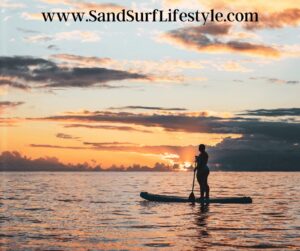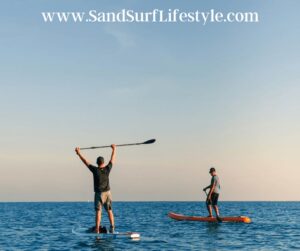Whether it is for sport or to earn a living, many people enjoy fishing. However, some coveted fishing spots are too small for a fishing boat, and cannot be reached by traveling on foot. So, what do you do? Recently, many people have begun to equip their paddle boards for fishing. This easily solves their conundrum of having a favorite fishing spot, but not being able to get an average-sized boat into that spot or get there by foot. Equipping a stand-up paddleboard (SUP) for fishing is a fairly easy task. All you have to know is which accessories and gear you need, and I’m here to tell you how to do the rest.
In this article, I will cover both inflatable paddleboard and rigid paddleboard fishing setups. I will explain the similarities and differences between the two types of paddleboards when it comes to setting them up for fishing. Finally, I will give a brief description of each accessory that completes the perfect SUP fishing setup. By the end of this article, you will know everything you need to know about setting your paddleboard up for a great day of fishing.
Which Paddleboard Should You Use For Fishing?
For those of you who may be new to the world of paddleboards, they can be found in either inflatable or rigid versions. While some people may prefer the portability of an inflatable paddleboard, others may prefer the stability of a rigid paddleboard. Whatever type of paddleboard you prefer, there is no wrong way to choose. We are going to compare both types of paddleboards and let you decide which one you think will best fit your needs.
Rigid Paddleboards
As their name would indicate, rigid paddleboards are hard and sturdy. These boards are generally made of plastic, fiberglass, or wood, and are what people think of when they picture a traditional paddleboard. The plastic variety of paddleboards has a little give to it, but it is also quite durable and heavy. The popularity of plastic paddleboards is on a slight downturn because of their weight. People usually buy paddleboards because they are light and portable, and the plastic versions typically are not.
On the other hand, the fiberglass versions of rigid paddleboards are incredibly lightweight, although they are somewhat stiffer than plastic paddleboards. You may want to avoid a fiberglass paddleboard if you plan on fishing in an area that has a lot of rocks, as they are not as good at handling an impact as a plastic version. With that said, the popularity of fiberglass paddleboards has recently taken an upward trend due to their lightweight design, which makes them more portable.
The final type of rigid paddle board is made from wood, but they are not seen nearly as often as they had been in the past. Of course, this is due to their weight, they are also the most durable and dependable of all the rigid paddleboards. Still, who wants to carry around a large, wooden paddleboard when there are models which are much lighter, and made of plastic or fiberglass? I certainly don’t, and I’m sure the rest of you will agree with me.
Inflatable Paddleboards
 What is the primary difference between an inflatable paddle board and a rigid paddleboard? You guessed it. Inflatable paddle boards are inflatable. There there is one reason that these paddleboards have become increasingly popular. They are white easy to transport and store. Because they can be deflated, inflatable paddleboards can be taken just about anywhere you want to go.
What is the primary difference between an inflatable paddle board and a rigid paddleboard? You guessed it. Inflatable paddle boards are inflatable. There there is one reason that these paddleboards have become increasingly popular. They are white easy to transport and store. Because they can be deflated, inflatable paddleboards can be taken just about anywhere you want to go.
While you may not think that inflatable paddle boards are durable, you would be wrong. Believe It or Not, inflatable paddle boards are also known for their incredible durability. However, they are not going to be as durable as a rigid paddle board made of wood, fiberglass, or plastic. A bonus of owning an inflatable paddleboard is that you do not have to worry about accumulating any dents or dings on your fishing trip. The only downside to owning an inflatable paddleboard is having to inflate and deflate it every time you want to use it.
How Do I Set Up My SUP For Fishing?
If you want to purchase a paddleboard for fishing, I have good news for you. There are some models of paddleboards that are made specifically for fishing and include plenty of tie-down points, mounts, and gear tracks. You choose to set up your paddleboard yourself, it can be accomplished fairly easily. Let’s start by adding Scott mounts to your SUP, which provide you with a way to carry all of the gear you need easily and conveniently. When it comes to Scott Mounts, you can either go with the Railblaza Ribport or the Scotty #341-BK Glue-On Pad for inflatable paddleboards.
If the idea of having to mess with sticky glue is not particularly appealing to you, and you prefer the peel-and-stick method when it comes to your mouth, the Railblaza Ribport is the right mount for you. Aside from being especially easy to stick to your SUP, these mounts are also quite versatile. They are capable of fitting rod holders, fish finders, and many other accessories that we will talk about later.
The Scotty #341-BK Glue-On Pad adheres quite well with the PVC that most inflatable paddle boards are made from. These also come with stainless steel fasteners. If you choose to do so, you can also opt for an adhesive mount rod holder. These also Bond very well with PVC, so you should have no problems attaching them to your inflatable paddleboard. They are an easy and convenient way for you to carry your fishing rods. However, some adhesive mount rod holders do not come with the adhesive. You may have to buy it separately.
Can you sit on a paddle board? Find out here.
What Accessories Do I Need To Set Up My SUP For Fishing?
Now, we get to the fun part. There are several accessories that you can purchase which will make your SUP fishing setup uniquely yours, and ensure that you have everything you will need for a fun and relaxing day of paddleboard fishing. They include:
● A cooler – Be sure the dimensions fit your SUP because you do not want a cooler that is too wide or too heavy for your paddleboard.
● A folding chair – This will benefit your back and legs as it will keep you in a raised position, which is more than comfortable than other chairs.
● Fishing rod holders – You are going to need a place to put yourself rod when you are paddling, and these are just the right thing to hold your rods securely.
● Fishing anchors – These will help to keep your paddleboard in place while you are fishing, instead of having it drift while you are trying to fish.
● Life vest – Federal law states that any passenger under the age of 13 must wear a life vest, and you must have a light desk onboard for each person.
 ● Paddle holder – Having a paddle holder on your SUP is a great idea because you are going to need a place to put your paddle while you are trying to fish.
● Paddle holder – Having a paddle holder on your SUP is a great idea because you are going to need a place to put your paddle while you are trying to fish.
● Dry storage bag – let’s face it. If you are fishing on your paddleboard, there are a few things that are bound to get wet. A dry storage bag will prevent this.
● Paddleboard cart – Because paddleboards are not exactly fun to carry, having one of these handy to pull your paddleboard would be a good idea.
● Polarized sunglasses – These sunglasses increase visibility and reduce glare, which is perfect for being able to spot fish while you are on your paddleboard.
● Your favorite fishing hat – What fishing gear list would be complete without your favorite fishing hat, which protects your face, neck, and ears from the sun?
Conclusion
There are lots of fun and exciting ways to equip your stand-up paddleboard for fishing. Whether you choose a rigid paddle board made of fiberglass, wood, or plastic, or you opted for an inflatable paddleboard, there are plenty of accessories available to you that can accommodate every one of your fishing needs. Once you have decided on what type of paddleboard you want to set up for fishing, and you have picked out all of the accessories you think you will need, the only decision you will have left to make is which one of your favorite fishing spots you will be hitting. Good luck!
Please note: This blog post is for educational purposes only and does not constitute legal or medical advice. Please consult a legal expert or medical professional to address your specific needs.

